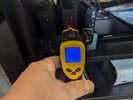-
Welcome to ASR. There are many reviews of audio hardware and expert members to help answer your questions. Click here to have your audio equipment measured for free!
You are using an out of date browser. It may not display this or other websites correctly.
You should upgrade or use an alternative browser.
You should upgrade or use an alternative browser.
Fosi v3 Mono - User Impressions | Owner's Thread
- Thread starter Guddu
- Start date
Guddu
Major Contributor
- Joined
- Feb 10, 2020
- Messages
- 1,558
- Likes
- 1,543
- Thread Starter
- #262
Same as mine, goes underneath easily with that clearance.Thanks for the answer. I'm wondering if I can put these monoblocks in line under TV (front od monoblocks with front of TV panel. It seems it will fits. I have 50mm space
You can look at pictures in post#1.
PJ_Schmidt
Member
- Joined
- May 2, 2024
- Messages
- 17
- Likes
- 39
I checked the power and heat on my 2x V3 mono. I am connected through the RCA for all of these tests. Here's what I found:
With both units set to OFF: 2.2w
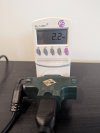
This is the power my power supplies waste when there is no demand. I'm not using the Fosi PS bricks, so they may be different.
Both in standby and set to 25db: 11.4w
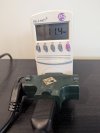
Subtracting the power loss in my PS and dividing in half, it appears each Mono is wasting 4.6w while in standby. To me this is perfectly acceptable.
Both in standby and set to 31db:
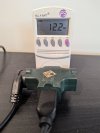
When set to 31db gain, the standby power loss increases to 5w each.
Both units ON and set to 25db: 22.6w
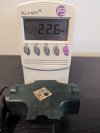
This with nothing playing.
Both units on and set to 31db: 23.5w
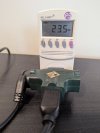
When on, the 31db setting appears to use 0.5w per unit more than when in the 25db setting.
When playing on average it's 1-2w above baseline for music at a comfortable volume (my speakers sensitivity is 88db@1w). My power measurement box updates fairly slowly, so it's hard to know if there are transients above that. I was able to see it briefly display 36w when playing an extremely energetic movie scene at reference levels (ie nearly deafening).
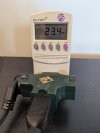
The temperature of the units is going to be strongly effected by each persons setup, so take the following with a grain of salt. Here's how mine are setup.
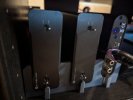
Mine are oriented vertically in a media cabinet that has minimal air flow. The front is sealed with a glass door and the shelf it is on is sold with no airflow from below. There are a few small openings in the back, but not a good path for airflow past the amps. I have no active cooling. My room is a 22c.
After 8hr in standby: 32c
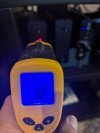
This slightly warm but very comfortable to touch. The top (side) of the unit 1-2c warmer than the front.
After 1.5hr playing music: 43c

This is warm, but not too hot to touch for extended periods.
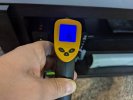
Top of the unit is 46c.
Overall none of these numbers cause me any concern. Let me know if you have any questions.
Phillip
With both units set to OFF: 2.2w

This is the power my power supplies waste when there is no demand. I'm not using the Fosi PS bricks, so they may be different.
Both in standby and set to 25db: 11.4w

Subtracting the power loss in my PS and dividing in half, it appears each Mono is wasting 4.6w while in standby. To me this is perfectly acceptable.
Both in standby and set to 31db:

When set to 31db gain, the standby power loss increases to 5w each.
Both units ON and set to 25db: 22.6w

This with nothing playing.
Both units on and set to 31db: 23.5w

When on, the 31db setting appears to use 0.5w per unit more than when in the 25db setting.
When playing on average it's 1-2w above baseline for music at a comfortable volume (my speakers sensitivity is 88db@1w). My power measurement box updates fairly slowly, so it's hard to know if there are transients above that. I was able to see it briefly display 36w when playing an extremely energetic movie scene at reference levels (ie nearly deafening).

The temperature of the units is going to be strongly effected by each persons setup, so take the following with a grain of salt. Here's how mine are setup.

Mine are oriented vertically in a media cabinet that has minimal air flow. The front is sealed with a glass door and the shelf it is on is sold with no airflow from below. There are a few small openings in the back, but not a good path for airflow past the amps. I have no active cooling. My room is a 22c.
After 8hr in standby: 32c

This slightly warm but very comfortable to touch. The top (side) of the unit 1-2c warmer than the front.
After 1.5hr playing music: 43c

This is warm, but not too hot to touch for extended periods.

Top of the unit is 46c.
Overall none of these numbers cause me any concern. Let me know if you have any questions.
Phillip
Attachments
Pelagic
New Member
- Joined
- Feb 13, 2024
- Messages
- 4
- Likes
- 6
Got the shipping notification from Fosi this morning for my V3 Mono*2 + 48V/10A Power Supply*1. When I got the "power filters are delayed" email 9 days ago I told them to ship the amps now and the filters when they're ready. I was backer #69.
No pops here either. And yes, here too a clunky relay switch sound when they’re turned on (either auto or manual). It doesn’t bother me, it’s like many other amps.there is relay click type of sound when they power on. Not any kind of pop through the speakers. Is the click normal?
D
Deleted member 72219
Guest
I hear the relay noise at the amp as well—nothing from the speakers.No pops here either. And yes, here too a clunky relay switch sound when they’re turned on (either auto or manual). It doesn’t bother me, it’s like many other amps.
-Ed
Ah yes, at the amps indeed. Line to speakers is clean.I hear the relay noise at the amp as well—nothing from the speakers.
-Ed
Something else for those wondering: auto power on isn’t instant but it is damn fast. Half a second or so?
Cool, relay clicks don’t bother me in the least. I just read a lot of people mentioning no noise at auto power-on, so wanted to confirm that just meant no speaker noise and that the relay was normal.No pops here either. And yes, here too a clunky relay switch sound when they’re turned on (either auto or manual). It doesn’t bother me, it’s like many other amps.
With both units set to OFF: 2.2w
I believe that's illegal in the EU: home electronics, including a/v equipment, are not allowed to consume more than 0.5w in off/standby modes. From the technical point of view, it's hard to argue why an electronic device would need 2.2w in off mode, that's just bad design.it appears each Mono is wasting 4.6w while in standby
antcollinet
Grand Contributor
It's not a standby mode in the meaning/intent of the EU legislation - which is intended for the mode when you have turned off a device with the remote, but it is still retains enough functionality to be turned back on with the remote - Ie has not had power fully removed.I believe that's illegal in the EU: home electronics, including a/v equipment, are not allowed to consume more than 0.5w in off/standby modes. From the technical point of view, it's hard to argue why an electronic device would need 2.2w in off mode, that's just bad design.
So in terms of the legislation, this amp doesn't have a standby mode. I suspect they've simply used a power down mode of the TPA chip to disable the output switching.
Regarding off mode, the remaining losses will be in the power supply - in which nothing is done to reduce power, because there is no off switch for that except at your socket if you are lucky enough to live in a country (eg UK
Sokel
Master Contributor
- Joined
- Sep 8, 2021
- Messages
- 9,561
- Likes
- 10,264
Yes.It's not a standby mode in the meaning/intent of the EU legislation - which is intended for the mode when you have turned off a device with the remote, but it is still retains enough functionality to be turned back on with the remote - Ie has not had power fully removed.
So in terms of the legislation, this amp doesn't have a standby mode. I suspect they've simply used a power down mode of the TPA chip to disable the output switching.
Most of the remaining losses will be in the power supply - in which nothing is done to reduce power.
Some pro amps name this function "amp disable" and can be done with a switch or time controlled.
In this case the amp is shutting down and PSU works in low power mode.
I am running 2 V3s with separate 5A power supplies with identical signals to power my 2 center channel speakers [Magnepan CC3s with a quoted impedence of 4 Ohm and a sensitivity of 86dB/W/m (probably lower)]. They are both sitting flat on the solid second shelf of a TV stand with no sides below a solid shelf with an air gap of about 6 inches and they are 4 feet apart. The lower shelf below one V3 holds my Pioneer SC-LX901 receiver, the other my Carver A753 amplifier. Ambient temperature in the room is 78F (25.5C). After running for about an hour watching a rom-com (no explosions or loud transients), the V3 above the receiver was 120F (49C) and the one above the Carver was 115F (46C). Interestingly, the Pioneer also runs at 120F, the Carver only 100F. I've swapped the amp locations to see if the temperature difference is due to the receiver underneath or if one amp really runs 5 degrees hotter than the other. I DO get a turn-on thump through one of the speakers if I turn on the V3 before my receiver, but as long as I turn on the V3 last no thump (but there is a relay click). I have ordered CPU cooling fans and will update with temperatures once I receive them. I'm still very happy with the sound of the V3s, but I do worry about longevity like others due to the high temperatures.
antcollinet
Grand Contributor
but I do worry about longevity like others due to the high temperatures.
Almost certainly the lower devices are heating up the shelf, and thereby heating up the V3s. They are not seeing the room ambient of 25, but something higher due to heat from below.
But, given that, they are not that high - or to put it another way, why worry about the V3, but not the Pioneer/Carver.
thunderchicken
Active Member
I think very hot is accurate, and no, there was not any thermal compound on mine between the internal heat sink and the case. I did not check whether there was thermal compound between the internal heat sink and chip.Based on the various user reports, it seems that there is a (perceived) difference in how hot these things run, ranging from “warm” to “very hot”.
I’m curious if these differences are merely subjective or might be due to technical causes.
Some users reported that there is no cooling paste between heatsink and case. Has that been the case for everyone so far or do some users have received units with cooling paste?
GoDawgs
Member
It is only 16 deg F or 9 deg C over average body temperature according to a post above. Aren't there other amps that run normally and uneventfully at those temps? Is 46 deg C after extended playing periods normally a concern for amps? I'm don't know much about amp operating temps but I'm curious about the normal operating temperature range of most home amps.I think very hot is accurate,
A wiim mini tucked away connecting to your balanced dac through the optical might just work fine, and get all the streaming features ... and I suppose the wiim ultra might also connect to your balanced dac too (for the screen) ... but then your phone controller also has a screen ... (my thinking on this anyway, as I was looking too).I was thinking of using my 2xV3 mono with wiim ultra
unfortunately I discovered that it has no xlr output, which is essential for me
what a shame !
I'd put that in the 'desirable' rather than essential camp myself as there are workarounds.I was thinking of using my 2xV3 mono with wiim ultra
unfortunately I discovered that it has no xlr output, which is essential for me
what a shame !
Mine is to use the Wiim's digital output into a separate DAC that has XLR outputs, as a bonus it gives me a really nice heaphone amp, extra inputs and a physical volume knob so it earns it's place as an extra otherwise unwanted box, but just a properly made RCA/XLR connection would probably also work for me.
Similar threads
- Replies
- 23
- Views
- 1K
- Replies
- 5
- Views
- 941
- Replies
- 2
- Views
- 230
- Replies
- 25
- Views
- 2K
